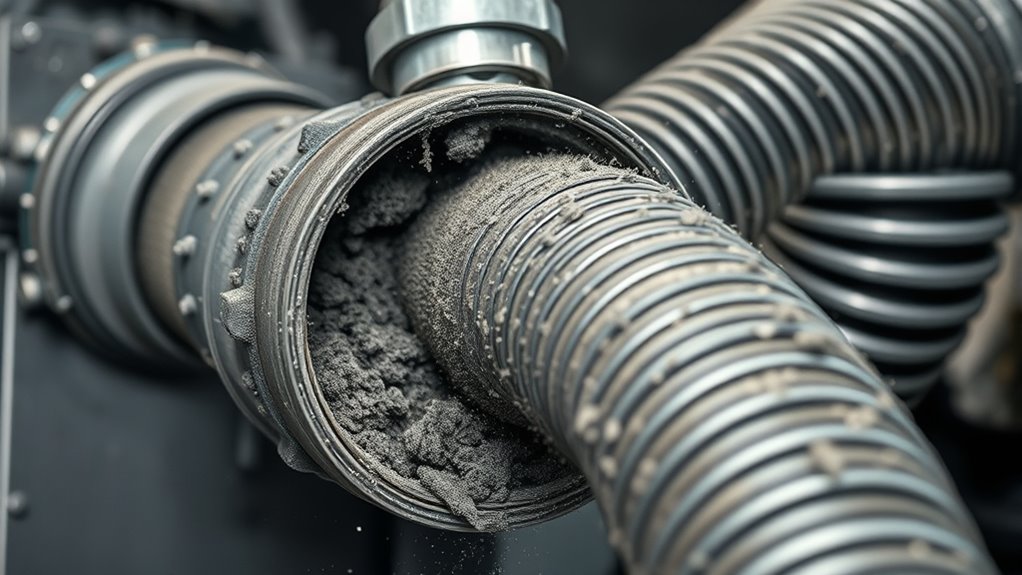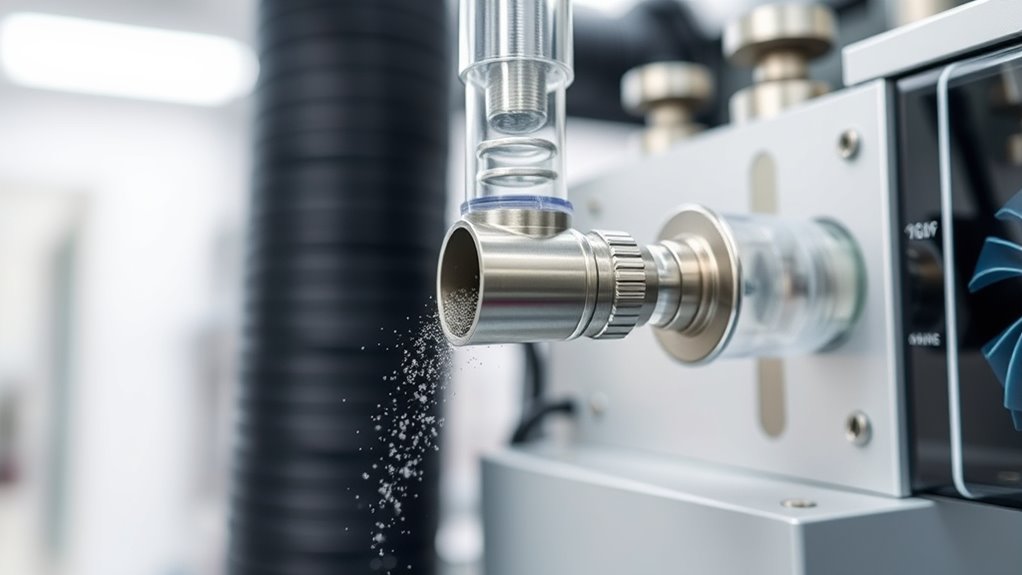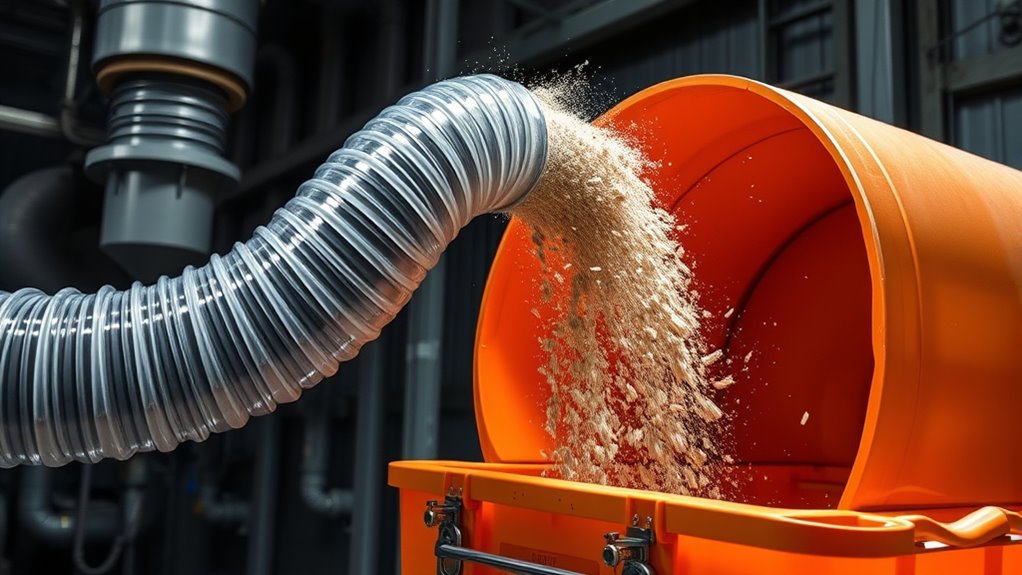When filters clog or become overwhelmed, bypassing them to vacuum waste directly is often the smart move to keep your operation running smoothly. This prevents equipment strain, overpressure, or damage caused by dirty filters blocking airflow or fluid flow. It also helps avoid costly downtime and repairs. Knowing when to bypass safely can save your system from major issues. Stay tuned to discover how to determine the best moments and ensure your process stays protected.
Key Takeaways
- Bypassing the filter is advisable during filter clogging to prevent system overload and maintain continuous operation.
- Use bypass when filters are damaged or leaking to protect sensitive equipment from contaminated airflow or fluid.
- Employ bypass protocols during scheduled maintenance to avoid downtime and facilitate quick filter replacements.
- Activate bypass if filter replacement is delayed, ensuring system performance while avoiding motor strain and overheating.
- Implement bypass options during emergency system failures to quickly isolate contaminated filters and safeguard overall process integrity.
Recognizing Filter Clogging and Maintenance Challenges

Filters in vacuum systems can become clogged more quickly than you might expect, especially if you don’t recognize the early signs. When filters are dirty, you’ll notice a drop in suction power and longer cleaning times. Increased motor strain may cause overheating or strange noises, signaling the filter needs attention. Dust and debris buildup can also lead to visible blockages or a decline in airflow. Regularly checking your filters helps prevent unexpected failures. If you see dust escaping or the vacuum isn’t performing as it should, it’s a clear sign that maintenance is overdue. Ignoring these signs can result in more extensive damage or costly repairs down the line. Staying vigilant about filter condition keeps your vacuum running efficiently and extends its lifespan. Proper filter maintenance is essential for optimal performance, especially considering how exfoliating dead skin cells can impact overall appliance efficiency.
Protecting Sensitive Equipment From Contaminants

Protecting your sensitive equipment from contaminants is vital to prevent damage and maintain peak performance. When you implement proper safeguards, you extend the life of your machinery and reduce costly repairs. Focusing on contaminant control helps guarantee your equipment stays reliable over time. Embracing creative problem-solving approaches can also lead to innovative solutions for contamination challenges.
Preventing Contaminant Damage
Contaminants can pose serious risks to sensitive equipment, causing malfunctions, corrosion, or permanent damage. To prevent this, you need to take proactive steps. First, always use appropriate filters or bypass systems to block harmful particles before they reach critical parts. Second, regularly inspect and replace filters to maintain their effectiveness. Third, implement proper sealing and airtight connections to stop external contaminants from entering the system. These actions ensure contaminants don’t reach essential components, reducing the risk of costly repairs or downtime. Additionally, understanding the importance of air purifier maintenance dos and don’ts helps ensure your protective measures stay effective over time. Staying vigilant with maintenance and using the right protective measures helps keep your equipment safe from damage caused by unwanted particles. By controlling what gets in, you safeguard your investment and maintain peak performance.
Ensuring Equipment Longevity
To guarantee your sensitive equipment lasts longer, it’s essential to implement effective contamination control measures. Regular maintenance, proper filtration, and environmental controls prevent harmful particles from damaging your equipment. Using appropriate filters ensures contaminants are captured before reaching critical components. Monitoring airflow and pressure helps identify leaks or blockages early. Consider the following table for key strategies:
| Strategy | Action | Benefit |
|---|---|---|
| Use High-Quality Filters | Replace filters on schedule | Reduces particle ingress |
| Maintain Clean Environment | Regular cleaning of surroundings | Minimizes airborne contaminants |
| Monitor System Parameters | Check pressure and airflow regularly | Detects early signs of contamination |
| Seal Equipment Properly | Ensure all seals are intact | Prevents leaks and intrusion |
| Schedule Preventive Checks | Routine inspections | Extends equipment lifespan |
Implement these measures consistently for effective equipment protection. Implementing proper filtration can significantly reduce the risk of contaminants reaching sensitive components.
Managing High-Viscosity or Thick Fluids Efficiently

Managing high-viscosity or thick fluids can be challenging because their resistance to flow slows down pumping and increases wear on equipment. To handle these fluids effectively, consider these strategies:
- Use specialized pumps designed for high-viscosity materials, such as positive displacement pumps, which maintain steady flow rates.
- Heat the fluids slightly to reduce viscosity without damaging the properties, making pumping easier.
- Regularly maintain and lubricate equipment to prevent excessive wear caused by increased friction.
- For wireless monitoring of equipment performance, utilize Bluetooth technology to ensure real-time updates and maintenance alerts.
Reducing Downtime During Critical Operations

To keep your critical operations running smoothly, focus on minimizing interruptions and implementing bypass protocols for quick adjustments. Scheduling regular maintenance helps identify issues early and prevents unexpected breakdowns. By staying proactive, you can substantially reduce downtime and keep your process efficient. Additionally, understanding the importance of preventative maintenance can further enhance system reliability and reduce the need for emergency repairs.
Minimize Operational Interruptions
Minimizing operational interruptions is essential for maintaining efficiency during critical processes. To achieve this, you should:
- Schedule maintenance during planned downtime to avoid unexpected halts.
- Use reliable equipment with built-in redundancies to guarantee continuous operation.
- Train your team thoroughly so they can troubleshoot quickly and prevent prolonged outages.
- Incorporate preventive maintenance practices to identify potential issues before they cause failures.
Implement Bypass Protocols
Implementing bypass protocols guarantees that critical operations can continue smoothly even when equipment requires maintenance or encounters unexpected issues. You should establish clear procedures for activating bypass systems quickly, minimizing delays. Train your team thoroughly so everyone knows their role during a bypass, ensuring swift, coordinated action. Use reliable, tested hardware to prevent failures during bypass activation. Document every step of the protocol, including safety checks and communication channels, to avoid confusion. Regularly review and update procedures based on real-world experiences. Installing automated bypass triggers can speed up response times. By planning ahead, you reduce the risk of costly downtime and keep operations running seamlessly. Understanding system reliability is essential for designing effective bypass protocols that maintain operation integrity during disruptions. Effective bypass protocols are essential for maintaining productivity and safety, especially during unforeseen disruptions.
Schedule Regular Maintenance
Have you scheduled regular maintenance to keep critical systems running smoothly? It’s essential to prevent unexpected failures and minimize downtime. Here are three key steps:
- Create a Maintenance Calendar: Set specific dates for inspections and part replacements to ensure consistency.
- Perform Routine Checks: Regularly assess system components for wear, leaks, or anomalies that could cause failures.
- Document and Review: Keep detailed records of maintenance activities and analyze trends to improve future schedules. Incorporating signs of spoilage and other indicators can help identify potential issues early.
Cost-Effective Alternatives to Extensive Filtration Processes

When considering alternatives to extensive filtration processes, cost-effective options can substantially reduce expenses without sacrificing quality. You might explore simpler filtration methods, such as using basic sediment filters instead of complex systems, which are cheaper and easier to maintain. Additionally, implementing inline filtration at strategic points can target specific contaminants, minimizing the need for full-system overhauls. Using natural or biological treatments, like biofilters, can also cut costs while effectively removing impurities. Reassessing your current filtration setup to eliminate unnecessary stages helps streamline operations and lower expenses. Investing in versatile, reusable filter media can further reduce ongoing costs. Self Watering Plant Pots can serve as an example of how reducing overwatering and maintaining proper moisture levels can decrease the need for complex irrigation or filtration systems. Remember, balancing affordability with effectiveness ensures you maintain system integrity without overspending. These alternatives allow you to optimize your filtration process without breaking the bank.
Handling Emergency Situations and System Failures

Emergency situations and system failures can happen unexpectedly, so it’s essential to have a clear plan in place. First, identify your emergency shutdown procedures to quickly isolate the system and prevent damage. Second, guarantee you have accessible backup power sources to keep essential functions running during outages. Third, establish a communication protocol to inform your team and coordinate responses efficiently. Regularly train staff on these procedures so everyone knows their role during crises. Keep emergency kits nearby, including tools and safety gear. Periodically review and update your emergency plan to adapt to new risks. Being prepared minimizes downtime and prevents costly damage. Quick, decisive action is critical; knowing your steps in advance makes all the difference when seconds count.
Optimizing Processes With Temporary Bypass Strategies

During system failures or unexpected disruptions, implementing temporary bypass strategies allows you to maintain operations while addressing the core issue. Bypassing filters or critical components temporarily keeps processes running, minimizing downtime and preventing costly delays. To optimize this approach, identify the critical points that need bypassing and ensure alternative pathways are clear and secure. Use safeguards like pressure relief valves or flow restrictors to control flow and prevent damage. Document the bypass setup thoroughly, so you can revert to normal operations smoothly once repairs are complete. Regularly test bypass procedures during maintenance to ensure quick deployment when needed. By planning and executing these strategies effectively, you reduce operational interruptions and protect equipment, keeping productivity steady until permanent solutions are in place.
Frequently Asked Questions
When Is Bypassing the Filter More Advantageous Than Regular Maintenance?
You should bypass the filter when you’re dealing with a clogged or damaged filter that can’t be cleaned or replaced quickly, especially during urgent maintenance or troubleshooting. This prevents system shutdowns and allows continuous operation. However, only do this temporarily, as bypassing can let debris into sensitive components, risking damage. Always plan to replace or clean the filter as soon as possible for peak system performance.
How Does Bypassing Impact Overall System Safety and Compliance Standards?
Bypassing the filter can compromise system safety and violate compliance standards if not done carefully. It increases the risk of contaminants escaping, potentially harming operators and the environment. You should only bypass filters when necessary, ensuring proper safeguards are in place. Always follow regulatory guidelines and manufacturer instructions, regularly monitor the system, and document any bypass actions to maintain safety and compliance standards.
What Are the Best Practices for Implementing Temporary Bypasses Securely?
You should implement temporary bypasses by clearly limiting their duration, documenting each step, and using secure, lockable valves. Always inform your team beforehand, and verify proper training on bypass procedures. Regularly monitor the system during bypass, and remove the bypass as soon as the task is complete. This approach minimizes risks, maintains safety standards, and keeps your system compliant without compromising safety or quality.
Can Bypassing Filters Cause Long-Term Damage to System Components?
Yes, bypassing filters can cause long-term damage to system components. When you skip filtering, debris and contaminants can circulate freely, leading to wear and tear on sensitive parts like pumps, valves, and sensors. Over time, this unchecked particle flow can cause clogging, corrosion, or mechanical failure. To avoid costly repairs, only bypass filters when absolutely necessary and guarantee you restore the system to proper filtering as soon as possible.
How Do Operators Determine the Optimal Timing for Filter Bypass Procedures?
You should act when system pressure spikes or flow drops markedly, signaling filter clogging. Trust the saying, “A stitch in time saves nine,” and monitor gauges closely. Regularly check pressure differentials and follow manufacturer guidelines to determine appropriate bypass timing. By staying attentive, you’ll prevent damage and keep operations running smoothly, knowing when bypassing is necessary to maintain efficiency without risking long-term harm.
Conclusion
Think of bypassing the filter as taking a shortcut through a busy highway—sometimes it’s the quickest way to keep your system moving. When you recognize the signs of clogging or face urgent situations, bypassing can be your safety valve. Just remember, like any shortcut, it needs careful planning. Used wisely, it keeps your operations flowing smoothly, saving you time and money, and preventing a traffic jam in your process.









